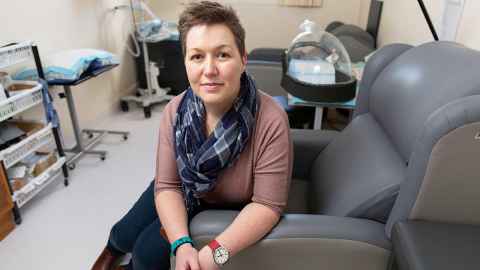In the house with Jennifer Miles-Chan
31 August 2021
The director of the University’s Human Nutrition Unit oversees important research on metabolism, obesity and markers for type 2 diabetes.

If another lockdown has seen you chowing down on chocolate, cheese and chips,
Dr Jennifer Miles-Chan may have just the healthy holiday destination for you once we’re back at level one.
Jennifer is a nutritional physiologist and the director of the Human Nutrition Unit (HNU), a rather unique research facility under the School of Biological Sciences. After completing a doctorate in physiology at the University of Auckland, she worked on her postdoc at the University of Fribourg in Switzerland, where she stayed for almost nine years.
“There was a big chocolate factory right next to campus … living in the land of chocolate and cheese was great.”
Jennifer returned to New Zealand in 2017 to take up a Sir Charles Hercus Health Research Fellowship for advanced postdoctoral study, awarded by the Health Research Council (HRC).
She now oversees the HNU, succeeding founding director Professor Sally Poppitt who returned to the UK in July, undertakes research and conducts her regular teaching duties.
The HNU is a circa 1900 ex-boarding house in Mt Eden, bought to conduct in-house research. It’s an unlikely site, and the outside could do with a lick of paint, but several rooms have been refurbished to become labs and kitchens, and five nice bedrooms remain for participants to ‘live in’ for nutrition studies that require close monitoring. Those studies measure the likes of metabolic rates or how people process different foods.
“Sugar by itself isn’t the bad guy. It’s the fact that we’re more likely to over-consume energy in the sugar form,” says Jennifer.
When people are living in the house, we tightly control what they eat, so we can test cause and effect.

Measuring metabolic rate involves participants being hooked up to a monitor for three hours, watching mundane movies that neither excite them nor bore them so much that they fall asleep.
“We measure how much oxygen they take in, how much carbon dioxide they expel and get an idea of how many calories they are burning and where those calories are coming from.”
The HNU is a busy place. Taimi Theresa Alipia, originally from Samoa on an HRC Pacific Health Research PhD Scholarship, measures why some people respond differently to the same ‘challenge’ as others, such as exposure to the cold.
Participants, clad in liquid conditioning suits that cool skin temperature, are exposed to different temperatures to see how it affects their metabolism.
The rise of obesity and type 2 diabetes is a global issue, and several projects, funded by HRC and the Ministry of Business, Innovation and Enterprise (MBIE), investigate aspects of this health crisis.
One, recruiting now, is the Synergy Study which requires people to live-in-house for two weeks and only eat what they’re given. What’s on offer sounds appealing – a chef cooks up the likes of Omega-3 lamb and Mt Cook salmon.
The study being undertaken at the HNU is recruiting Pākehā and Chinese participants to examine why, despite a low body mass index, many people of Chinese heritage store fat more readily in unhealthy sites (like within their pancreas and liver) and therefore face a higher risk of type 2 diabetes.
“There’s a high degree of obesity and diabetes in Asia – in China alone more than 100 million people have diabetes, and at least another 400 million have prediabetes,” says Jennifer. “Chinese also exhibit what’s called TOFI, thin on the outside and fat on the inside. So it’s really useful to measure that as a risk factor.”
The two-week study, which can only happen at level one, feeds the residents two different diets, either the healthy diet or the Synergy diet, both largely based on the Mediterranean diet.
“The only difference is that the Synergy diet is amped up with nutritional New Zealand food and beverage products.”
Synergy foods have been developed in partnership with High-Value Nutrition (HVN) Ko Ngā Kai Whai Painga, which is funded by MBIE and hosted by the University.
HVN’s goal is to develop the evidence base to support the health benefits of New Zealand foods, to boost the country’s reputation as a producer of quality, high-value foods. It supports research into novel foods, such as karengo, an indigenous seaweed, being developed by Ngāi Tahu and Wakatū Incorporation. Karengo, with evidence-based health benefits, could become a viable substitute for nori seaweed which is often in short supply.
Out in the community many others are doing the same on their own. For example, quinoa puffs are a healthy snack developed by a Taranaki couple. Jennifer and her team spotted them on Country Calendar.
“We pick our industry partners carefully and this couple stood for everything good in the world. They’re passionate about good nutrition. We got hold of them and now they’re one of the 13 companies we partner with and they sit in on the Zoom meetings alongside household names like Fonterra, Zespri and Sanitarium.”
Foods like these are included in the Synergy Study. The aim is to research the synergistic effect of a range of healthy New Zealand foods on participants who live at the unit for the fortnight of the study.
If we’re doing really good science and that’s translatable into clinical outcomes in New Zealand and also in key markets overseas, that’s good for everyone.

Jennifer is wary of the common practice of promoting the virtues of a single ‘wonder’ food. There are no silver bullets. The Synergy Study is based on a ‘whole diet’ approach.
A second study is a large community study on weight loss over a year. The first two months feature intensive weight loss programmes, with the remainder of the year focused on maintaining the healthier weight and improvements in blood glucose.
Jennifer says if people are in the community it’s hard to know how compliant they are with their diets.
“When people are living in the house, we tightly control what they eat, so we can test cause and effect. But you can’t test cause and effect in the community. We monitor compliance by doing urine and lipid tests which give a good idea. But there is a large degree of trust.”
Jennifer is also leading a novel area of research, the effect of the contraceptive pill on weight and energy metabolism.
“I started researching it when I was in Switzerland because I was shocked to find no one else was. A 2016 study found 89 percent of New Zealand females aged 35 to 69 have used oral contraceptives at some point in their lives. But we don’t know what they do to the body. We’ve looked at the cancer and cardiovascular risks but what about everyday stuff?”
She says research from the 1970s and 80s showed the pill can influence the way women digest and absorb vitamins and minerals.
A Cochrane review, a review of studies, found no evidence of any causative link between the pill and weight gain.
“But I looked at the obesity statistics and there was this big spike in women of childbearing age. Young women were somehow more susceptible or increasing their weight at a greater rate.”
PhD student Julia Cree is looking at how women on the pill handle and respond to glucose.
“They’re given a very sweet drink, and we measure their glucose and insulin. When women are on the pill, it seems they respond like a diabetic, or a prediabetic. If you’re young and healthy, that may be no biggie in the short term. But if you’re taking the contraceptive pill for ten to 20 years, that effect might accumulate over time.”
Women’s health is a real focus. A doctoral student, still in Iran, is wrangling large data sets from Denmark to identify any relationship between females’ specific hormonal factors at various points in adult life and body composition.
No two days are the same in Jennifer’s role.
“At the HNU we do health research and aim to do really high-quality internationally recognised science. And for some of what we do, the aim is to grow export revenues through HVN.
“If we’re doing really good science and that’s translatable into clinical outcomes in New Zealand and also in key markets overseas, that’s good for everyone.”
Denise Montgomery
Depending on Covid levels, Jennifer Miles-Chan will speak at the Foodomics High Value Nutrition Conference on 29 September about the Synergy NZ Diet for Diabetes Prevention.
This story first appeared in the September issue of UniNews.